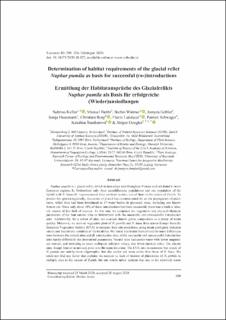Please use this identifier to cite or link to this item:
https://doi.org/10.21256/zhaw-20800Full metadata record
| DC Field | Value | Language |
|---|---|---|
| dc.contributor.author | Keller, Sabrina | - |
| dc.contributor.author | Babbi, Manuel | - |
| dc.contributor.author | Widmer, Stefan | - |
| dc.contributor.author | Gehler, Jamyra | - |
| dc.contributor.author | Hausmann, Sonja | - |
| dc.contributor.author | Berg, Christian | - |
| dc.contributor.author | Landucci, Flavia | - |
| dc.contributor.author | Schwager, Patrick | - |
| dc.contributor.author | Sumberova, Katerina | - |
| dc.contributor.author | Dengler, Jürgen | - |
| dc.date.accessioned | 2020-11-12T13:21:48Z | - |
| dc.date.available | 2020-11-12T13:21:48Z | - |
| dc.date.issued | 2020-11 | - |
| dc.identifier.issn | 0722-494X | de_CH |
| dc.identifier.issn | 0373-7632 | de_CH |
| dc.identifier.uri | https://digitalcollection.zhaw.ch/handle/11475/20800 | - |
| dc.description.abstract | Nuphar pumila is a glacial relict, which is nowadays rare throughout Europe and red-listed in most European regions. In Switzerland only three autochthonous populations and one population of the hybrid with N. lutea (N. ×spenneriana) have survived to date, one of them in the canton of Zurich. To protect this species regionally, the canton of Zurich has commissioned the ex situ propagation of speci-mens, which then had been introduced to 37 water bodies in protected areas, including one known former site. Since only about 10% of these introductions had been successful, there was a wish to identify causes of this lack of success. To this end, we compared the vegetation and physical-chemical parameters of the four natural sites in Switzerland with the successful and unsuccessful introduction sites. Additionally, for a subset of sites, we assessed diatom genus composition as a proxy of water quality. Moreover, we derived vegetation plots of N. pumila and N. lutea from across Europe from the European Vegetation Archive (EVA) to compare their site conditions, using mean ecological indicator values and bioclimatic variables of the localities. We found that inside Switzerland the main differences were between the natural sites and all introduction sites, while successful and unsuccessful introduction sites hardly differed in the determined parameters. Natural sites had cooler water with lower magnesi-um content, and according to mean ecological indicator values, also lower nutrient status. The diatom data, though limited in amount, point into the same direction. The EVA data demonstrate that stands of N. pumila are mainly more oligotrophic, but also cooler and more acidic than those of N. lutea. We could not find any factor that explains the success vs. lack of success of plantations of N. pumila in multiple sites in the canton of Zurich, but our results rather indicate that due to the relatively warm climate, the high atmogenic nitrogen input and the predominantly base-rich bedrock, the sites in the canton are generally not particularly well suited for N. pumila. We consider it therefore more promising to protect and possibly (re-)introduce N. pumila in other cantons with higher elevation, base-poor bedrock and lower atmogenic nitrogen input. | de_CH |
| dc.language.iso | en | de_CH |
| dc.publisher | Floristisch-Soziologische Arbeitsgemeinschaft | de_CH |
| dc.relation.ispartof | Tuexenia | de_CH |
| dc.rights | Licence according to publishing contract | de_CH |
| dc.subject.ddc | 333.7: Landflächen, Naturerholungsgebiete | de_CH |
| dc.subject.ddc | 580: Pflanzen (Botanik) | de_CH |
| dc.title | Determination of habitat requirements of the glacial relict Nuphar pumila as basis for successful (re-)introductions | de_CH |
| dc.type | Beitrag in wissenschaftlicher Zeitschrift | de_CH |
| dcterms.type | Text | de_CH |
| zhaw.departement | Life Sciences und Facility Management | de_CH |
| zhaw.organisationalunit | Institut für Umwelt und Natürliche Ressourcen (IUNR) | de_CH |
| dc.identifier.doi | 10.14471/2020.40.022 | de_CH |
| dc.identifier.doi | 10.21256/zhaw-20800 | - |
| zhaw.funding.eu | No | de_CH |
| zhaw.originated.zhaw | Yes | de_CH |
| zhaw.pages.end | 326 | de_CH |
| zhaw.pages.start | 309 | de_CH |
| zhaw.publication.status | publishedVersion | de_CH |
| zhaw.volume | 40 | de_CH |
| zhaw.publication.review | Peer review (Publikation) | de_CH |
| zhaw.webfeed | Vegetationsökologie | de_CH |
| zhaw.author.additional | No | de_CH |
| zhaw.display.portrait | Yes | de_CH |
| Appears in collections: | Publikationen Life Sciences und Facility Management | |
Files in This Item:
| File | Description | Size | Format | |
|---|---|---|---|---|
| 2020_Keller-Babbi_etal_Determination-of-habitat-requirements_Tuexenia.pdf | 7.26 MB | Adobe PDF |  View/Open |
Show simple item record
Keller, S., Babbi, M., Widmer, S., Gehler, J., Hausmann, S., Berg, C., Landucci, F., Schwager, P., Sumberova, K., & Dengler, J. (2020). Determination of habitat requirements of the glacial relict Nuphar pumila as basis for successful (re-)introductions. Tuexenia, 40, 309–326. https://doi.org/10.14471/2020.40.022
Keller, S. et al. (2020) ‘Determination of habitat requirements of the glacial relict Nuphar pumila as basis for successful (re-)introductions’, Tuexenia, 40, pp. 309–326. Available at: https://doi.org/10.14471/2020.40.022.
S. Keller et al., “Determination of habitat requirements of the glacial relict Nuphar pumila as basis for successful (re-)introductions,” Tuexenia, vol. 40, pp. 309–326, Nov. 2020, doi: 10.14471/2020.40.022.
KELLER, Sabrina, Manuel BABBI, Stefan WIDMER, Jamyra GEHLER, Sonja HAUSMANN, Christian BERG, Flavia LANDUCCI, Patrick SCHWAGER, Katerina SUMBEROVA und Jürgen DENGLER, 2020. Determination of habitat requirements of the glacial relict Nuphar pumila as basis for successful (re-)introductions. Tuexenia. November 2020. Bd. 40, S. 309–326. DOI 10.14471/2020.40.022
Keller, Sabrina, Manuel Babbi, Stefan Widmer, Jamyra Gehler, Sonja Hausmann, Christian Berg, Flavia Landucci, Patrick Schwager, Katerina Sumberova, and Jürgen Dengler. 2020. “Determination of Habitat Requirements of the Glacial Relict Nuphar Pumila as Basis for Successful (Re-)Introductions.” Tuexenia 40 (November): 309–26. https://doi.org/10.14471/2020.40.022.
Keller, Sabrina, et al. “Determination of Habitat Requirements of the Glacial Relict Nuphar Pumila as Basis for Successful (Re-)Introductions.” Tuexenia, vol. 40, Nov. 2020, pp. 309–26, https://doi.org/10.14471/2020.40.022.
Items in DSpace are protected by copyright, with all rights reserved, unless otherwise indicated.